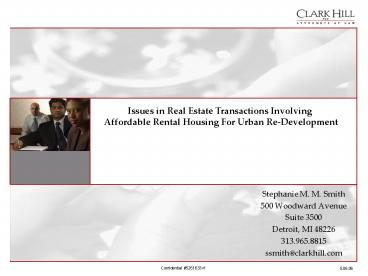Stephanie M. M. Smith - PowerPoint PPT Presentation
1 / 16
Title:
Stephanie M. M. Smith
Description:
Title: Title or Logo COUNT ON MORE Last modified by: Clark Hill PLC Created Date: 4/6/2006 4:27:47 AM Document presentation format: On-screen Show – PowerPoint PPT presentation
Number of Views:129
Avg rating:3.0/5.0
Title: Stephanie M. M. Smith
1
- Stephanie M. M. Smith
- 500 Woodward Avenue
- Suite 3500
- Detroit, MI 48226
- 313.965.8815
- ssmith_at_clarkhill.com
2
THE ROLE OF A DEVELOPMENT ATTORNEY DIFFERS FROM A
TRADITIONAL COMMERICAL REAL ESTATE ATTORNEY
- FIRST, THE NOTION HERE IS NOT JUST TO GET THE JOB
DONE, BUT TO REBUILD COMMUNITIES, LIVES AND
RECONSTRUCT CULTURAL MORES AND NORMS. - SECOND, THE LEGALITY OF STRUCTURING A DEAL CAN BE
QUITE HARROWING TO SAY THE LEAST WITH VARIOUS
ENTITY FORMATIONS AND LASAGNA FINANCING. - THIRD, THE CLIENT MOST LIKELY WILL BE
UNSOPHISTICATED IN UNDERSTANDING THE DEVELOPMENT
PROCESS AND IS DRIVEN TO DEVELOP FROM AN
EMOTIONAL STANDPOINT AND NOT MERELY AN ECONOMICAL
STANDPOINT.
3
ESTABLISHING AND STRUCTURING THE VARIOUS LEGAL
EXISTENCES OF THE ENTITY TO TAKE TITLE TO THE
PROPERTY
- 1. Non-profit Organization
- 2. Joint Venture Partnership
- 3. Limited Dividend Housing Association Limited
Partnership
4
1. Non-Profit Organization
1. NON-PROFIT ORGANIZATION
- Non-Profit Organization will form a Community
Development Corporation (CDC), which allows the
501 (c) (3) organization to provide services to
community for housing, jobs, and commercial
space. - The CDC may form a more discrete entity such as
the Community Housing Development Organization
(CHDO) for the sole process of developing
affordable housing. - Board members of the CDC consist of local
residents who are generally not in the business
of real estate development or finance.
5
2. JOINT VENTURE PARTNERSHIP
- Generally, the CDC will form a joint venture
partnership with a for-profit developer to
increase the likelihood of success for financing
and completing the project. - Generally, a for-profit developer (for-profit)
will be encouraged to joint venture with a CDC to
achieve access/connection to the community. - The CDC will maintain a 51 interest in the
partnership and the for-profit will maintain a
49 interest in the partnership.
6
3. LIMITED DIVIDEND HOUSING ASSOCIATION LIMITED
PARTNERSHIP
- The Joint Venture will agree to structure a
limited dividend housing association limited
partnership (LDHA-LP) to allow the partners to
seek tax credit financing. - The Non-Profit will form a for-profit
wholly-owned subsidiary and the For-Profit will
form a single-purpose entity, such as a limited
liability company. These formed entities will
act as the Co-General Partners in the LDHA-LP
maintaining a .01 interest in the LDHA-LP. - The Non-Profit will act as the Initial Limited
Partner in the LDHA-LP. This entity will
maintain a 99.99 interest in the LDHA-LP.
7
THE LDHA-LP SCHEMATIC STRUCTURE
8
KEY ISSUES IN NEGOTIATING AND STRUCTURING THE
PARTNERSHIP AGREEMENTS
- Pre-Development Agreement
- 2. Limited Partnership Agreement
9
1. PRE-DEVELOPMENT AGREEMENT
- KEY CONCERNS
- Roles and Responsibilities for the Non-Profit and
the For-Profit Partners - The Specifics of the Development Project
- Terms and Conditions of the Financing Structure
- Developers Fee Provision
- Remedies/Liabilities Provision
10
2. LIMITED PARTNERSHIP AGREEMENT
- KEY CONCERNS
- The roles and responsibilities of the co-general
partners as it relates to the Partnership - The Capital Contributions and Percentage of
Interests - Powers, Restrictions, and Responsibilities
- Distribution on Termination
- Tax Matters
- The Co-General Partners are designated as tax
matters partner of the partnership and shall
engage in such undertakings as are required of
the tax matters partner of the partnership as
provided in regulations pursuant to Section 6231
of the Code
11
MOST-NEGOTIATED THIRD PARTY AGREEMENTS
- CONSTRUCTION AGREEMENT
- Details the construction schedule, pay-ins, and
eligible basis for getting tax credits - MANAGEMENT/MARKETING AGREEMENT
- Details the manner in which the premises are to
be maintained in a manner suitable to the equity
lenders and the governing state and local
regulations
12
THE PARTNERSHIP MISSION AND FINANCING
- KNOW THE CONSUMER MARKET
- Census data (population and income) existing
services, market studies, financial proformas,
target/market rent - KNOW THE SUPPORT MARKET
- Investor Support (traditional, government,
foundations), government support,
non-profit-support, residential association
support - What are the important sources and attached
regulations (New Market Tax Credits, Historic Tax
Credits, Community Development Block Grants) - How to leverage one funding source with another
- How to effectively use debt
- Combination with familiar sources (i.e., Low
Income Housing Tax Credits, HOME Funds, etc.) - Using the Government public improvements,
architectural services, etc.
13
REVIEW AND NEGOTIATE THE LOAN DOCUMENTS FROM ALL
POSSIBLE SOURCES OF FUNDING
- Tax Syndication Loans via
- Low-Income Housing Tax Credits
- Historic Tax Preservation Credits
- New Market Tax Credits
- Community Development Block Grants (CDBG)
- HOME Loans
- Private Bank Loans
14
REVIEW AND ENSURE REGULATORY DOCUMENTS ARE IN
PLACE AND THAT ENTITY COMPLIES FULLY WITH ALL
LOCAL LAWS AND REGULATIONS
- Title Work
- Environmental Reports
- Site Control Letters
- Site Plan Approvals
- Market Study
- Zoning Letter
- Non-Profit Status Letter
15
RE-EXAMINING THE PROJECT WITH THE OWNERSHIP
ENTITY TO ENSURE ITS CAPABILITY OF MAINTAINING AN
OWNERSHIP OR RENTAL COMMUNITY THROUGHOUT THE LIFE
OF THE PROJECT
- UNDERSTAND THE EXIT STRATEGIES FOR THE VARIOUS
FINANCING NEEDED TO FUND THE PROJECT.
16
- Stephanie M. M. Smith
- 500 Woodward Avenue
- Suite 3500
- Detroit, MI 48226
- 313.965.8815
- ssmith_at_clarkhill.com






























